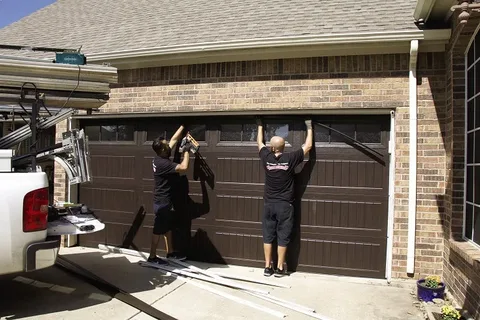Installing a new garage door can greatly enhance your home’s curb appeal, security, and energy efficiency. However, the process isn’t as simple as it may seem. Many homeowners make critical mistakes during their new garage door installation, which can lead to operational issues, reduced lifespan, and higher costs in the long run. Whether you’re replacing an old door or installing one for the first time, being aware of common pitfalls can save you time, money, and frustration.
1. Incorrect Measurements
One of the most frequent mistakes during new garage door installation is inaccurate measurements. Garage doors must fit perfectly within the frame to operate smoothly. Even being off by a few inches can cause significant issues.
Avoid it by: Measuring the width, height, side room, and headroom multiple times. It’s also wise to consult with a professional to verify your measurements before purchasing the door.
2. Choosing the Wrong Style or Material
Garage doors come in various materials—steel, wood, aluminum, fiberglass, and vinyl—each with unique benefits. A common mistake is selecting a door based solely on looks, without considering the climate, maintenance requirements, or durability.
Avoid it by: Researching different materials to match your region’s weather conditions and your maintenance preferences. For example, wooden doors are beautiful but require more upkeep, while steel doors offer durability and insulation.
3. DIY Installation Without Proper Experience
While there are countless DIY tutorials online, a new garage door installation isn’t a typical weekend project. The process involves heavy components, torsion springs under extreme tension, and precise alignment. One small misstep can lead to injury or expensive damage.
Avoid it by: Hiring a licensed and experienced garage door technician. Professionals have the tools and training needed to install the door safely and correctly.
4. Neglecting to Check Garage Door Opener Compatibility
Many homeowners forget to check whether their existing garage door opener is compatible with the new door. Modern doors may be heavier or require smart technology that older openers can’t support.
Avoid it by: Consulting with the installer or checking the specifications of both the new garage door and the opener. You may need to upgrade your opener to match the new door’s features and weight.
5. Ignoring Insulation and Energy Efficiency
Another overlooked factor during new garage door installation is insulation. Garage doors play a big role in your home’s energy efficiency, especially if the garage is attached to your house or used as a workspace.
Avoid it by: Choosing a door with the right R-value (a measure of thermal resistance). Insulated doors not only help reduce heating and cooling costs but also dampen noise and improve overall comfort.
6. Improper Spring Tension Adjustment
Garage door springs must be calibrated correctly to ensure balanced lifting and closing. Improper tension can make the door hard to open or close, damage the opener, or pose a serious safety risk.
Avoid it by: Leaving spring installation and adjustment to professionals. They’ll ensure the correct size and tension based on the weight and height of your door.
7. Not Testing the Door After Installation
After the installation is complete, skipping a full functionality test is a critical mistake. A door that looks good might still have alignment issues or sensor malfunctions.
Avoid it by: Conducting a complete test. Open and close the door several times, check the safety sensors, inspect the tracks and rollers, and ensure the opener functions smoothly. Address any issues immediately with the installer.
8. Poor Weatherproofing and Sealing
Even a perfectly installed garage door can fail if the weather sealing is inadequate. Water, wind, and pests can enter through gaps, leading to damage and discomfort.
Avoid it by: Ensuring all seals—top, bottom, and side—are properly installed and made from high-quality, durable materials. A good seal improves insulation and protects your garage interior.
9. Overlooking Local Building Codes and Permits
In some areas, installing a new garage door requires permits and must comply with local building codes—especially if it’s part of a broader renovation or if you live in a high-wind zone.
Avoid it by: Checking with your local municipality or HOA before beginning the installation process. A reputable installer will also be familiar with these requirements.
10. Hiring the Wrong Contractor
Choosing an inexperienced or unlicensed installer can lead to a botched job, frequent repairs, and safety concerns. It’s tempting to go with the cheapest quote, but that often comes with hidden costs.
Avoid it by: Researching companies thoroughly. Read reviews, check credentials, and ask for references. A professional and reputable contractor will ensure your new garage door installation meets industry standards.
Final Thoughts
A new garage door installation is a worthwhile investment that can improve your home’s value, safety, and appearance. However, to fully benefit from it, you must avoid the common mistakes that many homeowners make. By planning carefully, consulting professionals, and paying attention to details, you can ensure a smooth and successful installation.


